Appreciating Planets and Catching a Comet, Noctilucent Clouds, and Ogling Ophiuchus on Moonless Eves!
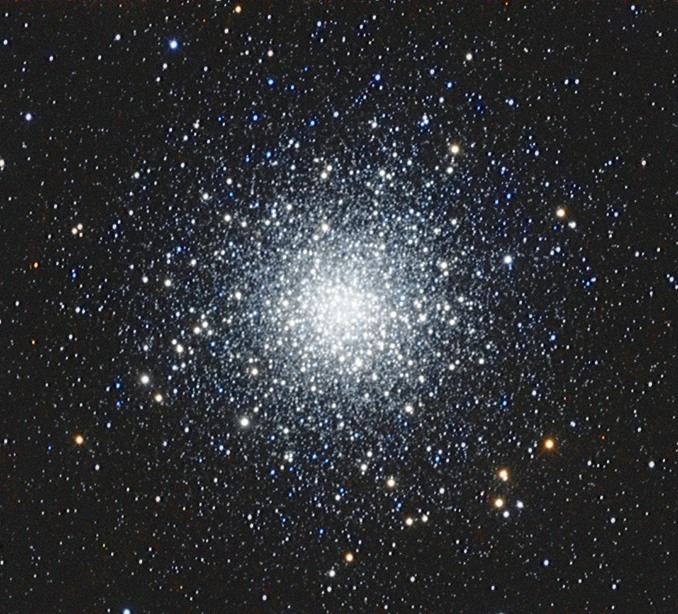
An image of globular the star cluster Messier 10, also known as NGC 6254, by Höcherl. The cluster spans about 40% of the full moon’s diameter. At magnitude 6.4, it can be seen with unaided eyes at a dark location, and in binoculars and through any size of telescope. It is estimated to be 14,300 light-years away. (Wikipedia)
Hello, July Stargazers!
Here are your Astronomy Skylights for the week of June 26th, 2022 by Chris Vaughan. Feel free to pass this along to your friends and send me your comments, questions, and suggested topics. You can also follow me on Twitter as @astrogeoguy! Unless otherwise noted, all times are expressed in Eastern Time. To subscribe to these emails please click this MailChimp link.
If you’d like me to bring my Digital Starlab portable inflatable planetarium to your school or other daytime or evening event, or deliver a session online, contact me through AstroGeo.ca, and we’ll tour the Universe, or the Earth’s interior, together! My terrific new book with John A. Read entitled 110 Things to See With a Telescope is a guide to viewing the deep sky objects in the Messier List – for both beginners and seasoned astronomers. DM me to order a signed copy!
The crescent moon will leave old and then return new as it passes the sun, leaving night skies worldwide dark for observing and for viewing Noctilucent clouds and a nice evening comet. We have one more week to see five bright planets in the eastern morning sky – as well as the faint asteroid Vesta and the two ice giant planets. I also demystify the zodiac and highlight a less-famous constellation, Ophiuchus. Read on for your Skylights!
The Moon
The moon will play peek-a-boo with Earthlings this week while it passes the sun, leaving night skies worldwide deliciously dark for summer stargazing.
Before it vanishes, though, our natural satellite will complete its monthly trip past the bright pre-dawn planets. Before sunrise on Monday morning the silver sliver of the old moon’s crescent will rise in the east-northeast at around 4:20 am local time. It will be shining several finger widths to the upper left (or 3.5 degrees to the celestial north) of the dot of Mercury – with much brighter Venus poised to their upper right, and the Pleiades cluster above that. Photo op! The moon and Mercury will share the view in binoculars, but be sure to turn optics away from the eastern horizon before the sun rises. Observers viewing from the tropics and the Southern Hemisphere will see all three objects shining in a darker sky among the stars of Taurus (the Bull).

A few southerly, sharp-eyed observers might be able to glimpse the moon’s razor-thin crescent (less than 1%-illuminated) sitting just above the northeastern horizon on Tuesday morning before sunrise. But turn away before the sun rises, please! On Tuesday at 10:52 pm EDT or 7:52 pm PDT, the moon will officially reach its new moon phase. (That converts to Wednesday, June 29 at 02:52 Greenwich Mean Time.) At the new phase the moon will be located in Gemini (the Twins), and less than 3 degrees north of the sun. Eagle-eyed observers will have about half an hour to look for the sliver of the young crescent moon (1%-illuminated) as it descends over the west-northwestern horizon starting about 9:20 pm.
With the moon swinging wider from the sun and waxing in illuminated phase, you’ll have no trouble seeing its slim crescent shining prettily in the northwestern sky after sunset on Thursday. Watch for Earthshine, also known as the Ashen Glow and “the old moon in the new moon’s arms”. That’s sunlight reflected off Earth and back toward the moon, slightly brightening the dark portion of the moon’s Earth-facing hemisphere. The phenomenon appears for several days after each new moon, but is strongest in springtime at mid-northern latitudes, when the moon is directly above the sun when it sets. The surrounding stars of Cancer (the Crab) may appear just as the moon sets.
Friday’s moon will be a delight, too. If your sky is dark and transparent enough around 10:30 pm local time, place the moon at the upper edge of your binoculars’ field of view and look toward the bottom for the cluster of stars known as the Beehive and Messier 44. The moon will spend the coming weekend nights stalking the stars of Leo (the Lion).
Noctilucent Clouds
The period from late May to mid-August, and especially around the June Solstice, is the best time for mid-Northern latitude observers to watch for noctilucent clouds (NLC) in the hours before sunrise and after twilight, especially when there is no bright moonlight. Those are very high clouds that form in the mesosphere layer of Earth’s atmosphere, 80-82 km above the ground. That’s high enough to catch and reflect sunlight while conditions are dark at ground level. Another name for them is polar mesospheric clouds (PMC).
The clouds form when very cold water vapour that develops in the stratosphere diffuses upwards and freezes around meteor dust particles that are descending from space. The mesosphere is coldest around the solstice. Visually, the clouds will appear as bright, cirrus-like ripples across the lower third of the northern sky, often tinted a silver-blue. If you see dark wisps of clouds overhead, those are regular cirrus clouds.
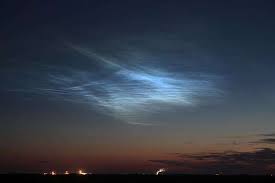
According to this terrific article from RASC, the first cloud sightings in North America were reported in 1933. The phenomenon may be increasing in frequency as climate change alters the upper atmosphere. More information, and a current polar map of the NLC coverage, can be viewed down the left-hand column of www.spaceweather.com. If you see them, or photograph them, tag me!
The Planets
We can still see the complete set of bright planets, arranged in their order from the sun, shining in the eastern predawn sky this week. But Mercury’s swing sunward will leave us with only four planets to appreciate next week.
With the planets spanning 120° of the ecliptic, the planetary parade technically starts at midnight, when the creamy dot of Saturn clears the east-southeastern horizon, surrounded by the modest stars of eastern Capricornus (the Sea-Goat). By sunrise, the ringed planet will be fading from view in the lower part of the southern sky. Any size of telescope will show you Saturn’s globe both above and below its rings, and up to a handful of its moons arrayed all around the planet. Since Saturn is now moving slowly westward in a retrograde loop that will last until late October, you can watch it shift to the right above Capricornus’ easterly tail stars Deneb Algedi and Nashira over the coming weeks.

The ecliptic is also strung with faint beads between the bright planet baubles. The main belt asteroid designated (4) Vesta will be positioned a generous fist’s diameter to Saturn’s lower left (or 12° to the celestial east). Vesta is slowing its roll through central Aquarius (the Water-Bearer) as it prepares to enter a period of retrograde motion. To see its magnitude 6.6 speck you’ll need to hunt for it with good binoculars or a backyard telescope after about 2 am local time and before the sky brightens. During the same interval, you can use a telescope to seek out the blue speck of magnitude 7.9 Neptune, which will be positioned a finger’s width to the right of a star named 20 Piscium along the line joining Jupiter to Saturn. They’re a fist’s diameter to the right of Jupiter. On Tuesday the eastward prograde motion of Neptune through the background stars of western Pisces (red path) will slow to a stop. After that it will commence a westward retrograde loop that will last until early December.
Before 2 am local time, the very bright, white dot of planet Jupiter will gleam above the eastern treetops, well to the lower left (east) of Saturn. Jupiter will be bright enough to remain visible until almost sunrise. The planet’s large globe, 11 times wider than Earth’s, will be flanked by its row of four Galilean moons. In a telescope, the planet will sport dark bands running parallel to its equator, the Great Red Spot on Monday, Wednesday, and Friday morning, and the small back shadow of Io crossing Jupiter on Wednesday morning. Jupiter will spend the next two months gliding through the northwestern corner of Cetus (the Whale).
Mars will clear the clear the trees by 3 am local time, appearing as a medium-bright, reddish dot shining 1.7 fist widths to Jupiter’s lower right. Mars’ distance from Jupiter will increase a little bit every morning. In a telescope, Mars will show a tiny, 86%-illuminated disk. The red planet will brighten very slowly and grow larger as Earth’s faster orbit draws us closer to it over the coming months.
The blue-green dot of Uranus is next in line, about midway between Venus and Mars. Its magnitude of 5.85 will allow you see it in binoculars and any size of telescope around 4 am local time – but it’s not located near any good guiding lights. The brightest star near it is the medium-bright star named Botein (or Delta Arietis). Uranus can be found several finger widths to its right (or 4° to the celestial southwest).
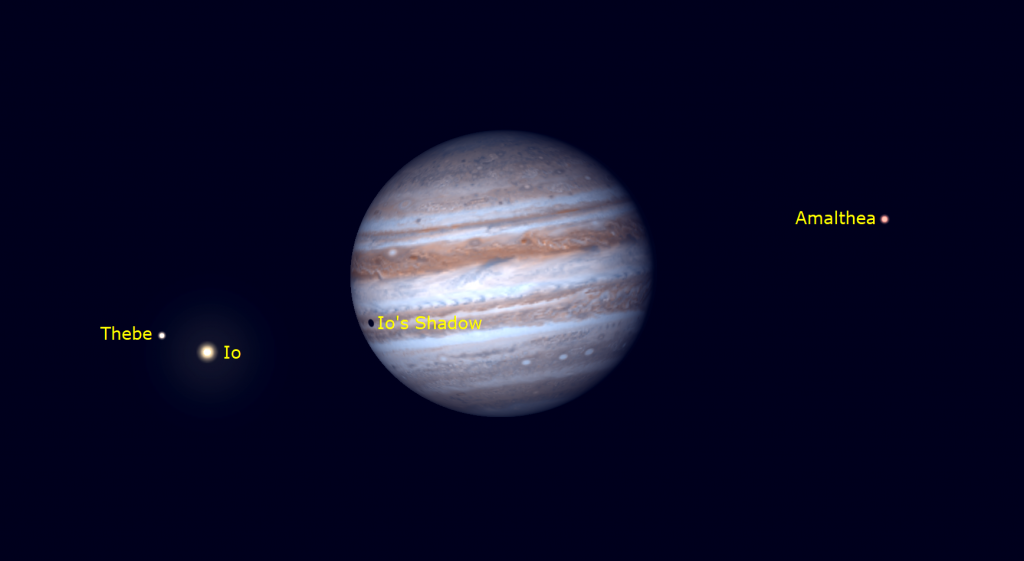
In mid-Northern latitudes, extremely bright Venus will rise over the east-northeastern horizon at 3:45 am local time every morning. While the stars in the eastern sky shift to the upper right (celestial west) each day due to Earth’s orbital motion around the sun, Venus is being held in place by its own countervailing eastward orbital motion – like a salmon suspended in a flowing river. You can see the effect by noticing how Venus’ relationship to the bright Pleiades star cluster above it changes each morning. If you view the Pleiades in twilight, you’ll be able to see only its brighter stars – the ones that suggest its other name, “the Seven Sisters”. Venus will exhibit a waxing, nearly-round shape when viewed in a telescope or in good binoculars.
Mercury will rise over the east-northeastern horizon at about 4:30 am local time – completing the chain of planets. Mercury’s position well below (or celestial south of) the sloping morning ecliptic is preventing observers at mid-northern latitudes from seeing the speedy planet very easily – but it’s also keeping the planet above the horizon even while it slides “leftward” toward the sun. If you want to see the planet, start looking at about 4:45 am in your local time zone. Turn all optics away from the eastern horizon before sunrise, please!
Ogling Ophiuchus
The moon won’t interfere with evening stargazing this week – so let me highlight the sights of the lesser-known constellation named Ophiuchus (the Serpent-Bearer). But first – a bit about the zodiac.
The twelve constellations of the zodiac are only famous and/or special because the great circle of the ecliptic carries the sun through each of them. The sun spends varying amounts of time crossing each constellation, and the entry and exit dates repeat every year. For example, in the present era, the sun traverses the constellation of Gemini (the Twins) from June 21 to July 19. (Remember, the sun isn’t moving – Earth’s orbital motion makes the sun appear to change location with respect to the fixed distant background stars.)
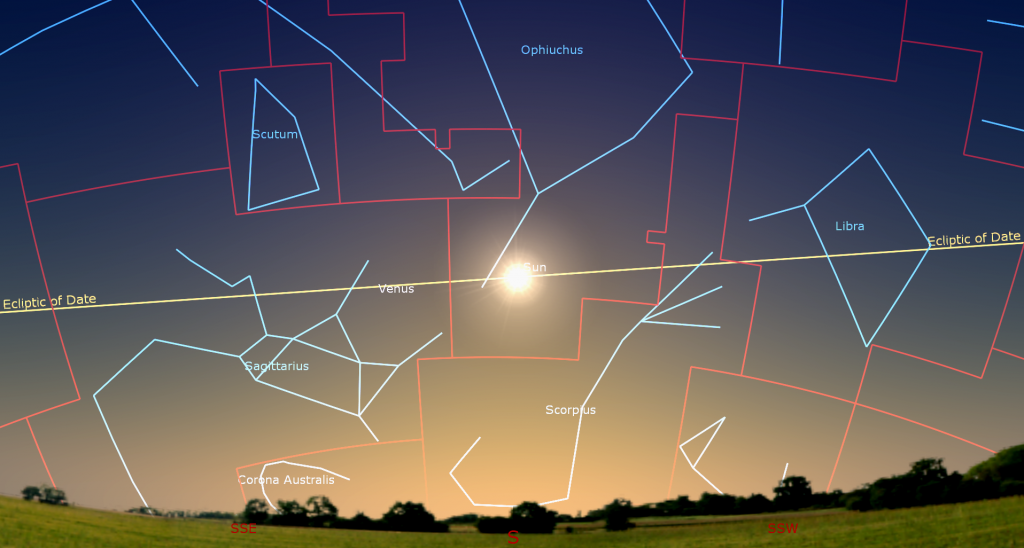
If you’re an astrology enthusiast, you’ll be wondering by now – why is the sun traversing Gemini in June and July if the Gemini “star sign” is for birthdays between May 22 and June 21? Well, thousands of years ago, when astrology was formulated by the Greeks and Babylonians, the sun did traverse the stars of Gemini during that part of the year. It’s one of many reasons why most astronomers place no value in astrological predictions. By the way – if you have an astronomy app or program that allows the year to be changed, you can set the app to noon, centre the sun, and then change the date to June 26th, 16 AD. The sun will hop into Cancer (the Crab), which sits east of Gemini!
Most of the Zodiac constellations are inconspicuous, if not nearly invisible, from the city and suburbs. Aries (the Ram) has two decently bright stars that form a little stick, while Cancer, Pisces (the Fishes), Aquarius (the Water Bearer), and Capricornus (the Goat) are seriously tough to make out – unless you travel to darker skies. A few constellations, Gemini (the Twins), Taurus (the Bull), Scorpius (the Scorpion), and Leo (the Lion), have very bright stars that form easily recognizable shapes. The rest of the dozen fall into the medium-bright range.
You may be surprised to learn that there is a thirteenth zodiac constellation! July is a good time to observe it, because that’s when it’s roughly opposite the sun in the sky. Ophiuchus (“Oh-fee-YOU-cuss”), the Serpent Bearer is a huge constellation (11th largest by area). It sits above and between (celestial north of) the Teapot-shaped asterism of Sagittarius (the Archer) and Scorpius. Lyra (the Lyre) and Hercules are above it. The ecliptic crosses the southernmost (lower) stars of Ophiuchus – but Ophiuchus has never been considered part of the zodiac because that would exceed the special system of 12 sky divisions important to ancient astrologers. If it were included, December babies would be Ophiuchans! In China, Ophiuchus is considered part of 天市左垣 (Tiān Shì Zuǒ Yuán), the Left Wall of the Heavenly Market Enclosure.
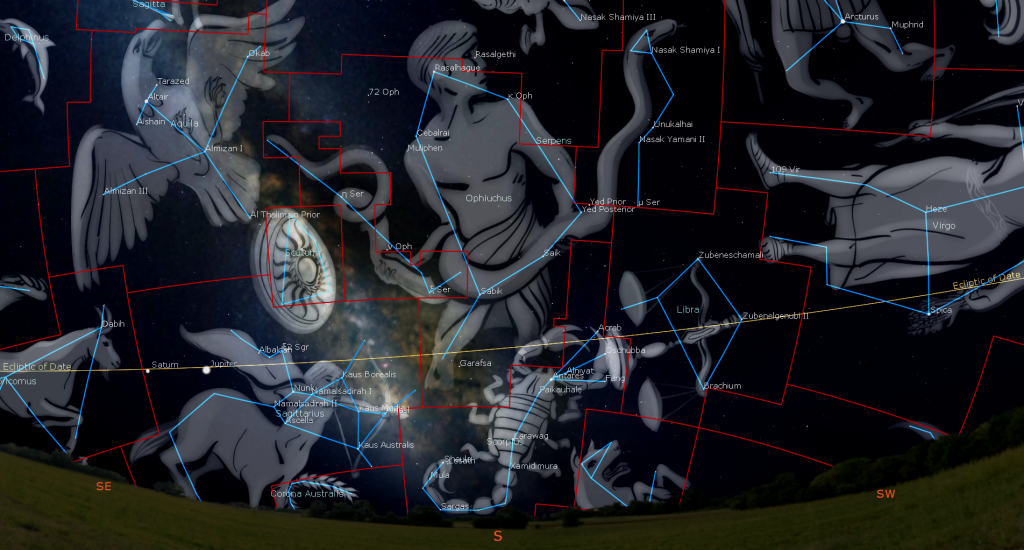
Ophiuchus’ stars are only medium-bright – so it’s another constellation that is better to trace out when the sky is darker. The constellation’s shape resembles a large, upright box (26° tall and 16° wide) with a pointed triangle forming the upper edge. (Think of a Dalek from Doctor Who.) The constellation’s brightest star, Rasalhague, from the Arabic raʼs al-ḥawwā, “the head of the serpent charmer”, marks the peak of that triangle. Rasalhague is located about midway between the very bright stars Vega and Antares. Rasalhague is a binary star system located about 48 light-years away. One of the two stars is spinning almost fast enough to break apart.
Ophiuchus’ second brightest star Cebalrai ”the shepherd’s dog” marks his eastern shoulder almost a fist’s diameter below (south of) Rasalhague. Also designated β Oph, magnitude 2.7 Cebalrai is an old sunlike star that has evolved to the stage where it has swelled and cooled to give it an orange colour. It is 82 light-years away. Ophiuchus’ western shoulder is marked by somewhat fainter Kappa Ophiuchi (or κ Oph). It, too, is almost a fist diameter from the head – toward celestial west – and it has also evolved to a cooler stage.
Immediately east and west of the main body of the Serpent-Bearer are two long sections of a separate, split-in-two constellation named Serpens. It’s the Serpent that Ophiuchus is bearing! The western (right) half is called Serpens Caput (the Snake’s Head), while the eastern (left) portion is Serpens Cauda (the Snake’s Tail). The Serpent-Bearer stands on the head of the scorpion, Scorpius. In Greek mythology, Ophiuchus saved Orion (the Hunter) from that creature’s venom. The bright stars of the Summer Triangle asterism are located to the upper left (celestial northeast) of Ophiuchus.
From east to west (left to right when viewed from the Northern Hemisphere), the stars forming the bottom of Ophiuchus’ boxy form are: medium bright Sabik “the preceding one”, dimmer Zeta Ophiuchi (or ζ Oph), and two dimmer stars a finger’s width apart named Yed Prior “leading hand” and Yed Posterior “trailing hand”. They represent his western hand. Yed Prior, the westernmost of the two, is extremely red in colour. Sabik is the star that Uranus’ northern axis of rotation points towards – the role played by Earth’s own pole star, Polaris! About a palm’s width to the upper left of the Yeds sits Marfik “the elbow” or λ Oph. In a telescope, 170 light-years-distant Marfik splits into a close-together pair of white stars.
You’ll need an astronomy app and a small telescope to see it, but Ophiuchus is home to Barnard’s Star – a magnitude 9.5, red dwarf located six light-years away from us. It is the fourth closest known star, and the closest star visible from the northern hemisphere. Barnard’s Star is located 3.5 finger widths to the left (or celestial east) of Cebalrai. Because it is so close to our solar system, we can actually watch Barnard’s Star travel through the galaxy in a process known as proper motion. It moves about half the moon’s diameter in a human lifetime.
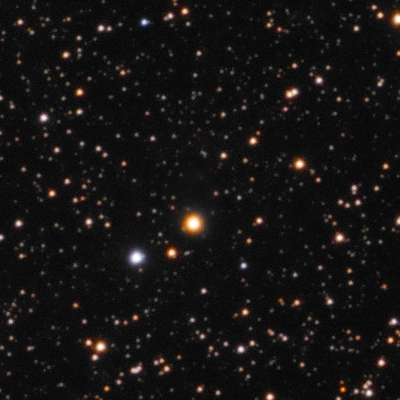
A handful of medium-bright stars are spread out to the lower left (celestial east) of Cebalrai. They form the gentleman’s pipe or flute – or the Dalek’s disruptor! Use binoculars to find the small, bright, open star cluster named IC 4665 located just to the upper left (or celestial north) of Cebalrai.
Because Ophiuchus sits just above the plane of the Milky Way, it is chock full of globular star clusters – spherical, tightly packed groups of stars that orbit our galaxy tens of thousands of light-years away from us. A large, reasonably bright one designated Messier 10 sits just about where the Serpent-Bearer’s belt buckle would be – with a slightly dimmer one Messier 12 to its upper right. Another bright globular named Messier 107 is located just below Zeta Ophiuchi, and another named Messier 14 sits about midway between Sabik and Cebalrai. You can see the clusters in binoculars or a small telescope, especially from a dark sky site.
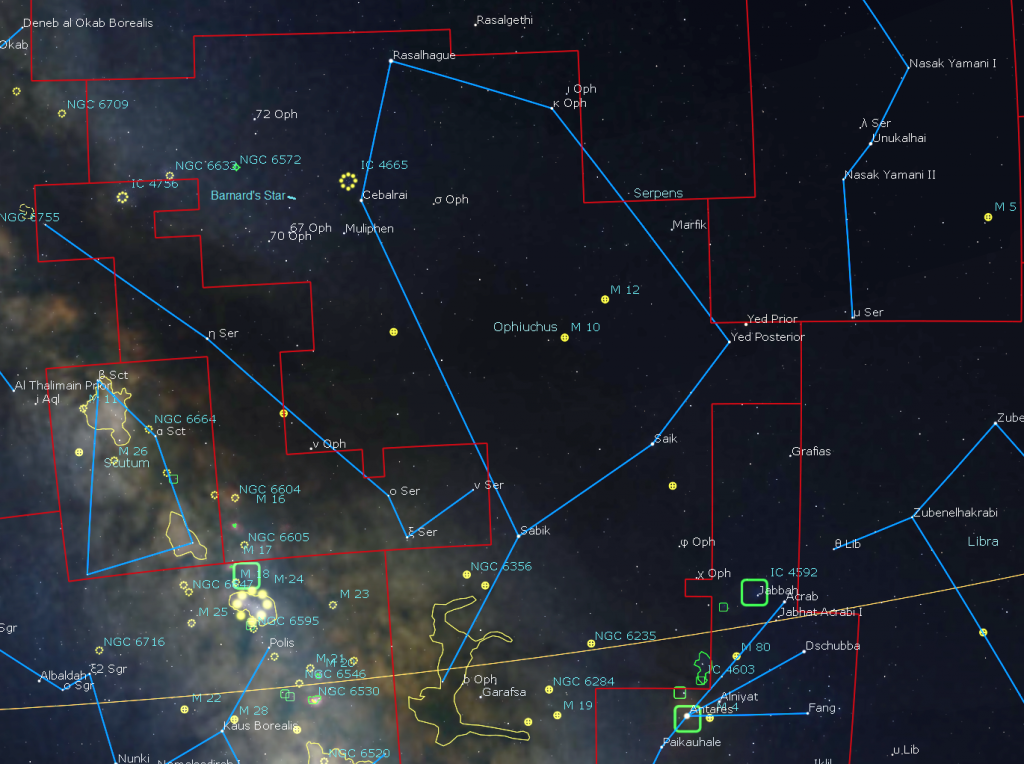
A little group of medium-bright stars, dominated by one brighter star named Garafsa or Theta Ophiuchi (or θ Oph), sit about a fist’s diameter to the lower right (or 10° to the celestial southeast) of Sabik. Those stars mark Ophiuchus’ eastern foot and are very close to the ecliptic. The Dark Horse, or Prancing Horse, is a dark dust region of the Milky Way that surrounds Garafsa. Measuring a fist’s diameter tall and several finger widths across, it can be captured in long exposure images. It can also be seen visually from southerly latitudes, where the constellation climbs higher in the sky.
The southeastern (or bottom) part of Ophiuchus dips into the Milky Way – so there are many more star clusters there. The star Rho Ophiuchi (or ρ Oph) in the southwestern corner of the constellation near the bright star Antares is gorgeous in long exposure photos. I posted one last week here. But even a small telescope will show Rho as a double star surrounded by even more stars! By 11:30 pm local time, the centre of Ophiuchus is positioned due south and about halfway up the sky. Let me know if you check it out!
Faint Comet Update
I have been writing about two comets that are currently observable in backyard telescopes in the evening sky, especially if you view them in non-light-polluted skies. In smaller telescopes, comets resemble fuzzy grey stars. In larger telescopes, you might see a hint of green colour and a faint tail pointed away from the sun.

Last Thursday, from a rural location about 20 km northeast of northern Toronto, I easily saw the brighter of the two, named C/2017 K2 (PanSTARRS), in a 10” reflector telescope. The comet is approaching its peak brightness of about magnitude 8.5. That might allow even binoculars to capture it from a very dark location.
This week, comet K2 will be travelling left to right (or celestial southwestward) through central Ophiuchus (the Serpent-Bearer). Look for Ophiuchus’ Dalek-shaped, boxy form sitting about halfway up the southeastern sky in late evening. Tonight (Sunday), the comet will be located two finger widths to the right (or 2° to the celestial southwest) of the bright star Cebalrai. The comet will be visible all night long, but it will be most easily seen while it is highest in the sky after midnight. On the coming weekend the comet will have shifted a palm’s width to the right of Cebalrai, nearing the medium-bright double star named 41 Ophiuchi.
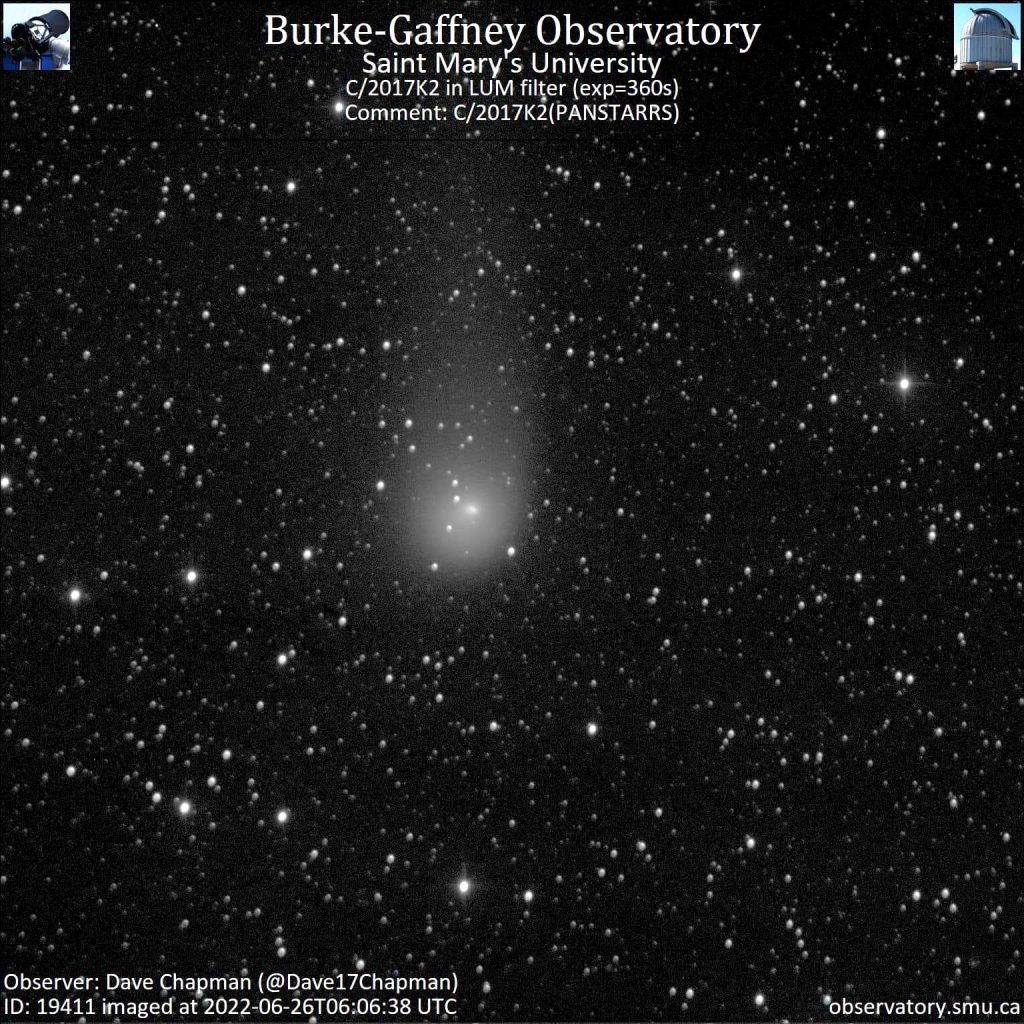
Exploring Hercules
In last week’s post, I focused on Hercules, which contains one of the summer season’s best objects! I posted it here.
Public Astro-Themed Events
Every Monday evening, York University’s Allan I. Carswell Observatory runs an online star party – broadcasting views from four telescopes/cameras, answering viewer questions, and taking requests! Details are here. They host in-person viewing on the first clear Wednesday night each month. Other Wednesdays they stream views online via the observatory YouTube channel. Details are here.
My free, family-friendly Insider’s Guide to the Galaxy webcasts with Samantha Jewett of RASC National returns on Tuesday, July 5 at 3:30 pm EDT, when we’ll celebrate Canadians in the Stars and a summer planet preview! Plus, we’ll continue with our Messier Objects observing certificate program and share some galaxy-viewing tips. You can find more details and the schedule of future sessions here.
Don’t forget to take advantage of the astronomy-themed YouTube videos posted by RASC Toronto Centre and RASC Canada.
Keep looking up, and enjoy the sky when you do. I love questions and requests. Send me some!